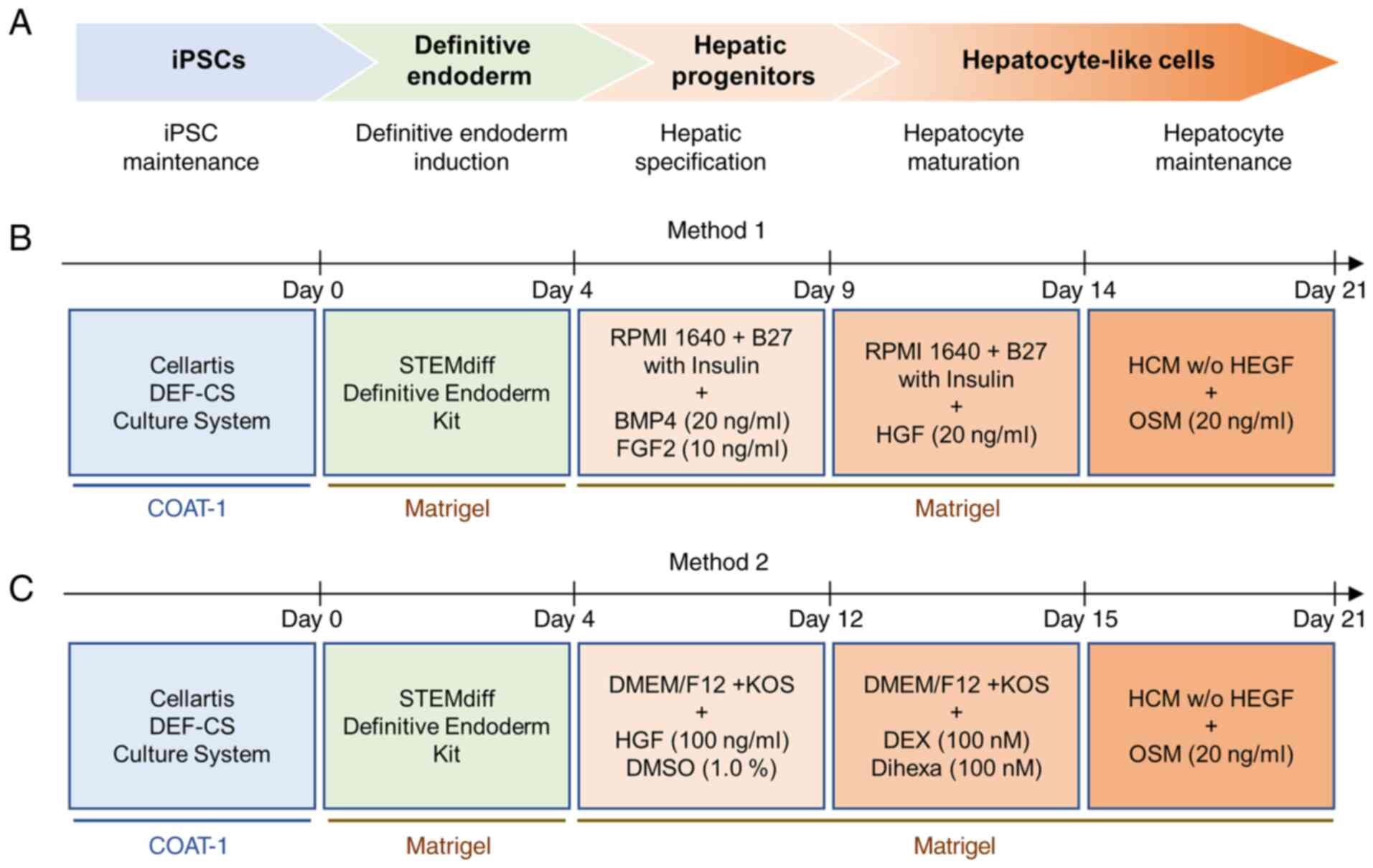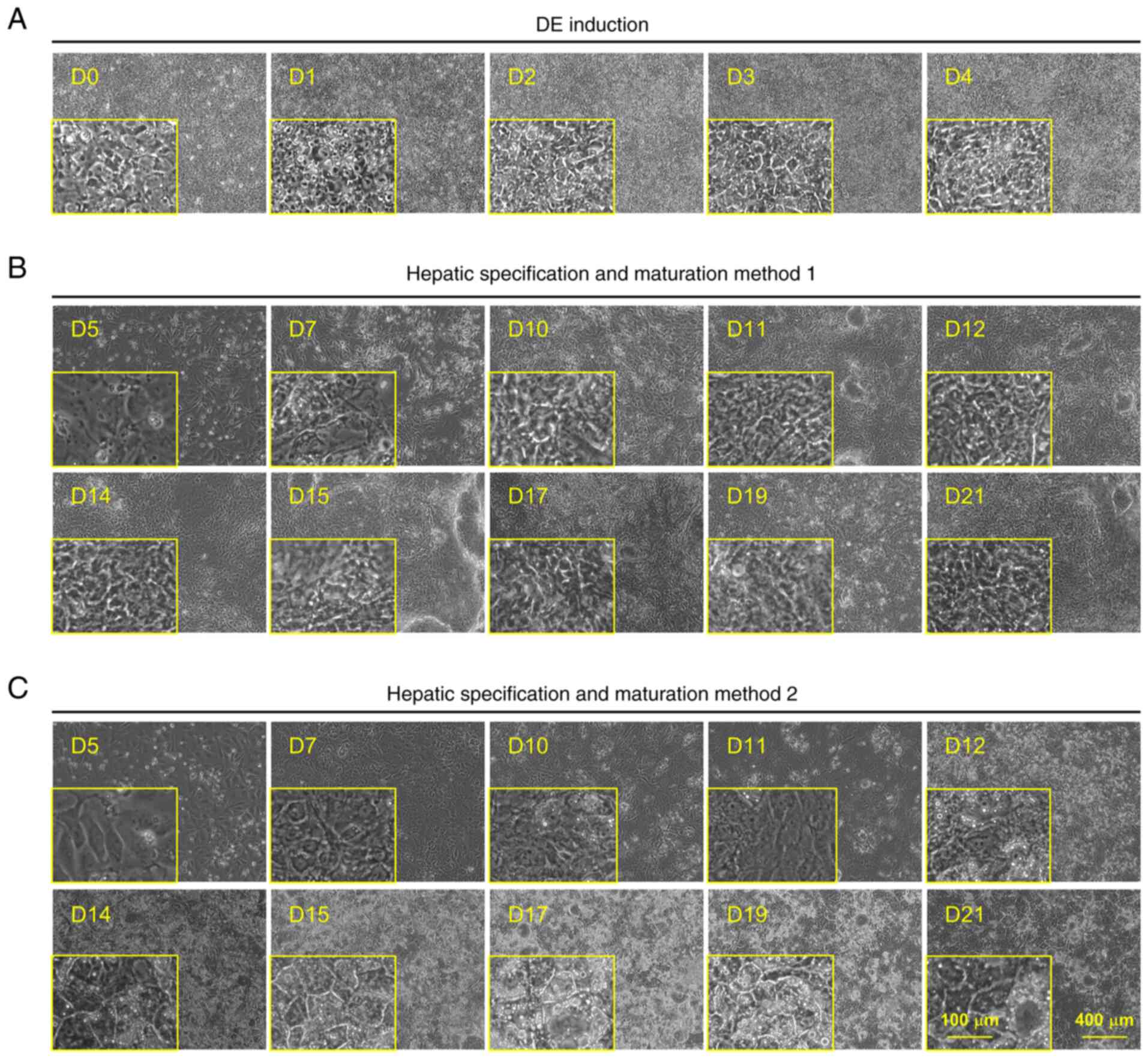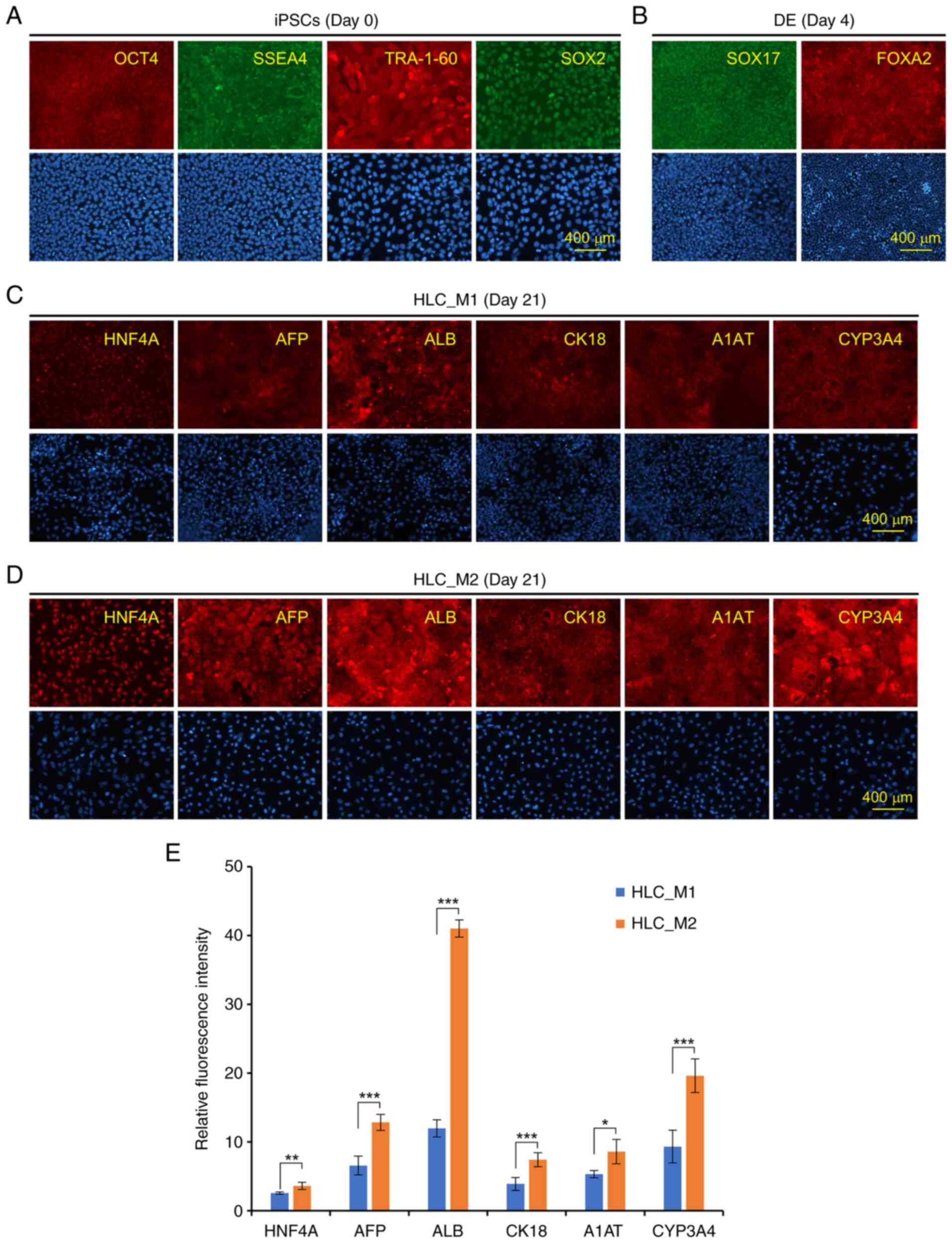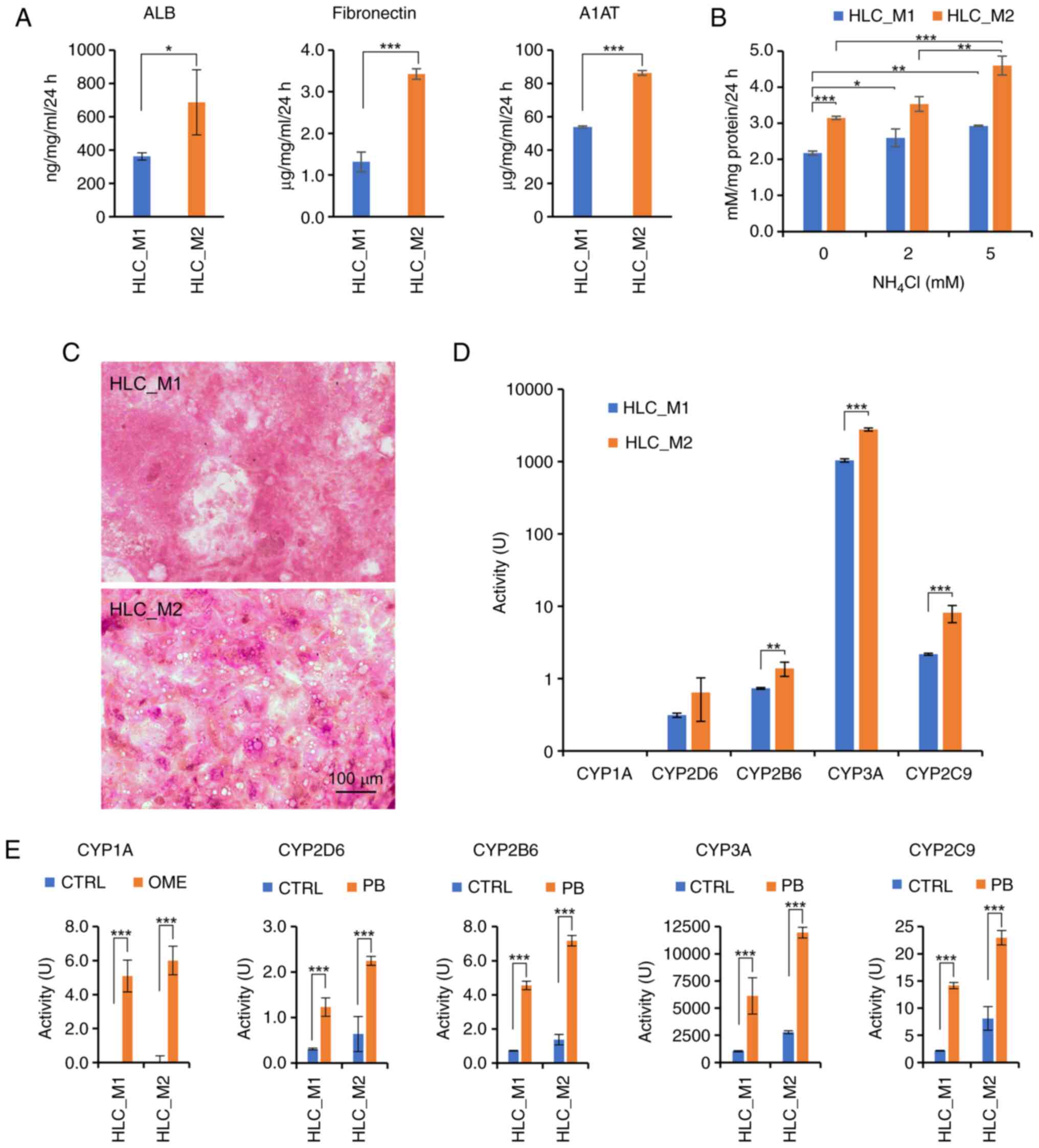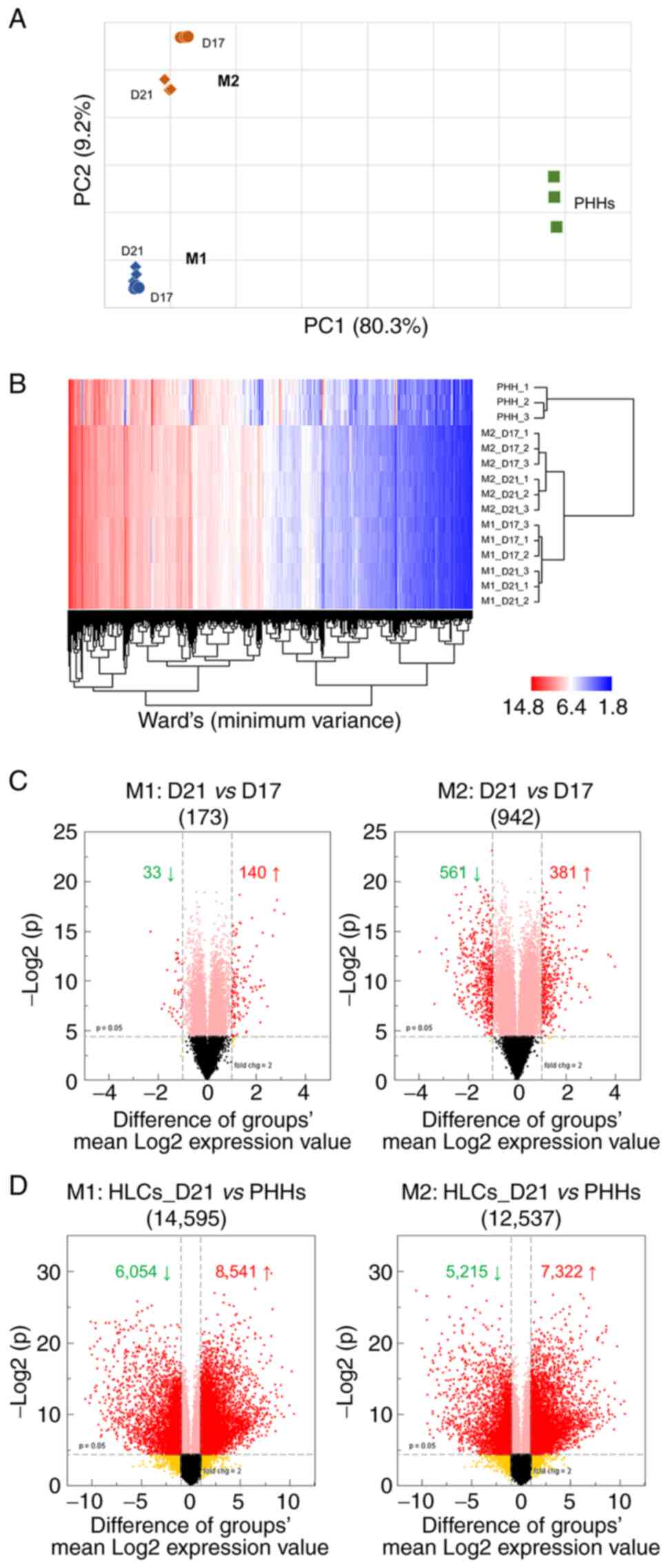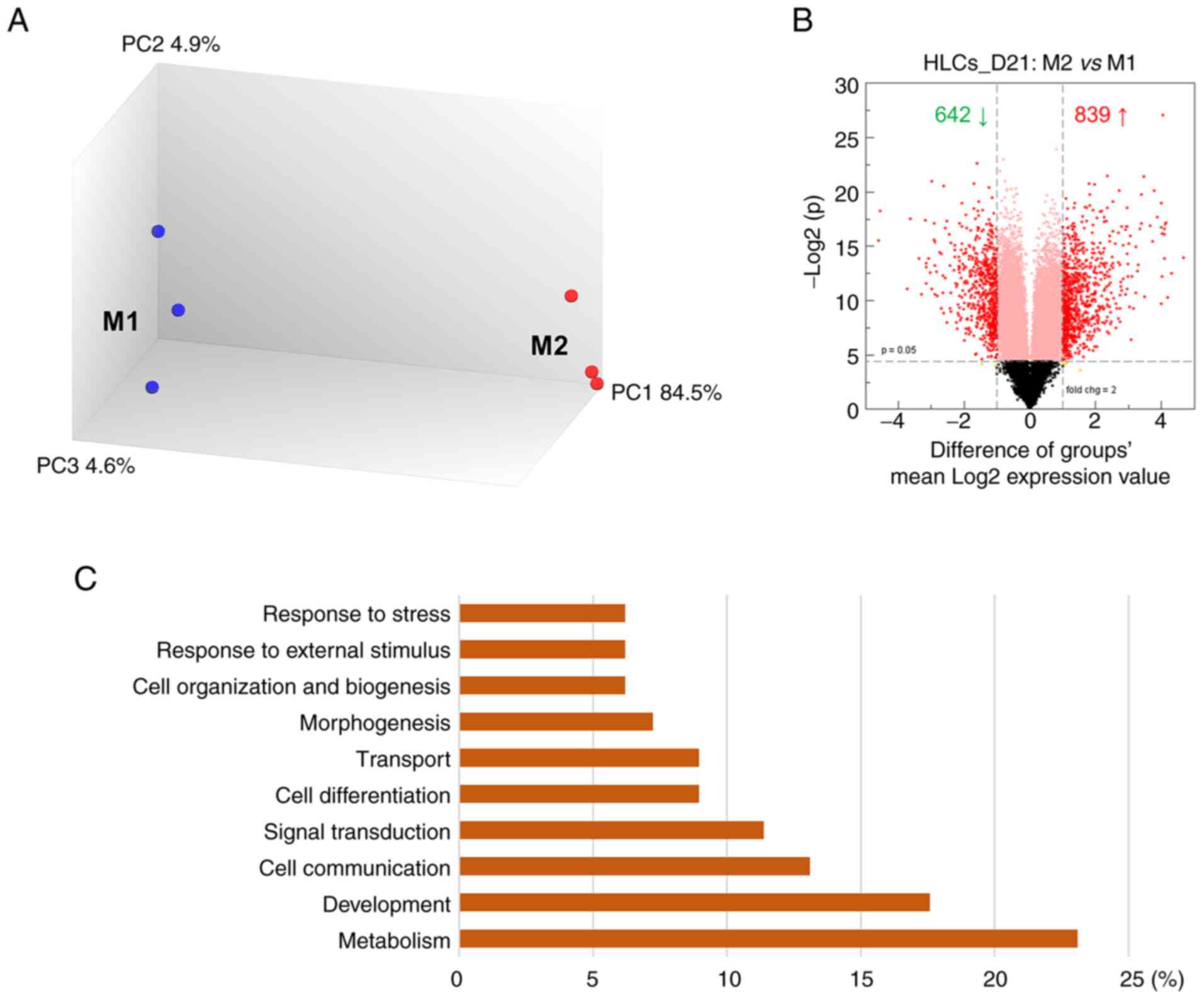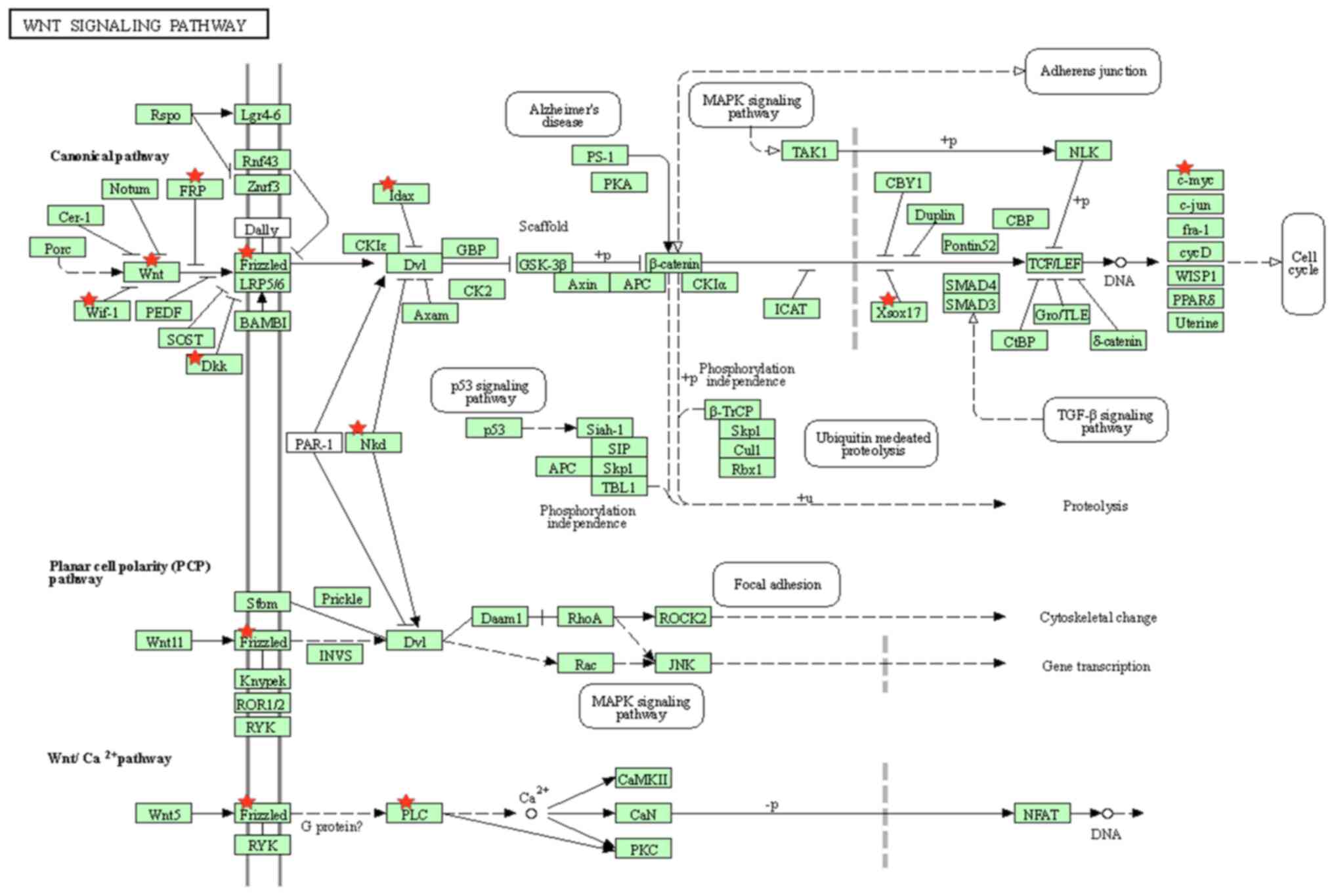|
1
|
Shi Y, Inoue H, Wu JC and Yamanaka S:
Induced pluripotent stem cell technology: A decade of progress. Nat
Rev Drug Discov. 16:115–130. 2017.PubMed/NCBI View Article : Google Scholar
|
|
2
|
Hannoun Z, Steichen C, Dianat N, Weber A
and Dubart-Kupperschmitt A: The potential of induced pluripotent
stem cell derived hepatocytes. J Hepatol. 65:182–199.
2016.PubMed/NCBI View Article : Google Scholar
|
|
3
|
Kogiso T, Nagahara H, Otsuka M, Shiratori
K and Dowdy SF: Transdifferentiation of human fibroblasts into
hepatocyte-like cells by defined transcriptional factors. Hepatol
Int. 7:937–944. 2013.PubMed/NCBI View Article : Google Scholar
|
|
4
|
Pournasr B, Asghari-Vostikolaee MH and
Baharvand H: Transcription factor-mediated reprograming of
fibroblasts to hepatocyte-like cells. Eur J Cell Biol. 94:603–610.
2015.PubMed/NCBI View Article : Google Scholar
|
|
5
|
Mallanna SK and Duncan SA: Differentiation
of hepatocytes from pluripotent stem cells. Curr Protoc Stem Cell
Biol. 26:1G.4.1–1G.4.13. 2013.PubMed/NCBI View Article : Google Scholar
|
|
6
|
Song Z, Cai J, Liu Y, Zhao D, Yong J, Duo
S, Song X, Guo Y, Zhao Y, Qin H, et al: Efficient generation of
hepatocyte-like cells from human induced pluripotent stem cells.
Cell Res. 19:1233–1242. 2009.PubMed/NCBI View Article : Google Scholar
|
|
7
|
Szkolnicka D, Farnworth SL,
Lucendo-Villarin B and Hay DC: Deriving functional hepatocytes from
pluripotent stem cells. Curr Protoc Stem Cell Biol. 30:1G.5.1–12.
2014.PubMed/NCBI View Article : Google Scholar
|
|
8
|
Siller R, Greenhough S, Naumovska E and
Sullivan GJ: Small-molecule-driven hepatocyte differentiation of
human pluripotent stem cells. Stem Cell Reports. 4:939–952.
2015.PubMed/NCBI View Article : Google Scholar
|
|
9
|
Du C, Feng Y, Qiu D, Xu Y, Pang M, Cai N,
Xiang AP and Zhang Q: Highly efficient and expedited hepatic
differentiation from human pluripotent stem cells by pure
small-molecule cocktails. Stem Cell Res Ther. 9(58)2018.PubMed/NCBI View Article : Google Scholar
|
|
10
|
Carpentier A, Nimgaonkar I, Chu V, Xia Y,
Hu Z and Liang TJ: Hepatic differentiation of human pluripotent
stem cells in miniaturized format suitable for high-throughput
screen. Stem Cell Res. 16:640–650. 2016.PubMed/NCBI View Article : Google Scholar
|
|
11
|
Wang Y, Alhaque S, Cameron K,
Meseguer-Ripolles J, Lucendo-Villarin B, Rashidi H and Hay DC:
Defined and scalable generation of hepatocyte-like cells from human
pluripotent stem cells. J Vis Exp. (55355)2017.PubMed/NCBI View
Article : Google Scholar
|
|
12
|
Siller R and Sullivan GJ: Rapid screening
of the endodermal differentiation potential of human pluripotent
stem cells. Curr Protoc Stem Cell Biol. 43:1G.7.1–1G.7.23.
2017.PubMed/NCBI View
Article : Google Scholar
|
|
13
|
Corbett JL and Duncan SA: iPSC-derived
hepatocytes as a platform for disease modeling and drug discovery.
Front Med (Lausanne). 6(265)2019.PubMed/NCBI View Article : Google Scholar
|
|
14
|
Takayama K and Mizuguchi H: Generation of
human pluripotent stem cell-derived hepatocyte-like cells for drug
toxicity screening. Drug Metab Pharmacokinet. 32:12–20.
2017.PubMed/NCBI View Article : Google Scholar
|
|
15
|
Gao X, Yourick JJ and Sprando RL:
Generation of nine induced pluripotent stem cell lines as an ethnic
diversity panel. Stem Cell Res. 31:193–196. 2018.PubMed/NCBI View Article : Google Scholar
|
|
16
|
Jung J, Zheng M, Goldfarb M and Zaret KS:
Initiation of mammalian liver development from endoderm by
fibroblast growth factors. Science. 284:1998–2003. 1999.PubMed/NCBI View Article : Google Scholar
|
|
17
|
Basma H, Soto-Gutiérrez A, Yannam GR, Liu
L, Ito R, Yamamoto T, Ellis E, Carson SD, Sato S, Chen Y, et al:
Differentiation and transplantation of human embryonic stem
cell-derived hepatocytes. Gastroenterology. 136:990–999.
2009.PubMed/NCBI View Article : Google Scholar
|
|
18
|
Schneider CA, Rasband WS and Eliceiri KW:
NIH image to imageJ: 25 Years of image analysis. Nat Methods.
9:671–675. 2012.PubMed/NCBI View Article : Google Scholar
|
|
19
|
Asplund A, Pradip A, van Giezen M,
Aspegren A, Choukair H, Rehnström M, Jacobsson S, Ghosheh N, El
Hajjam D, Holmgren S, et al: One standardized differentiation
procedure robustly generates homogenous hepatocyte cultures
displaying metabolic diversity from a large panel of human
pluripotent stem cells. Stem Cell Rev Rep. 12:90–104.
2016.PubMed/NCBI View Article : Google Scholar
|
|
20
|
Gao X, Li R, Sprando RL and Yourick JJ:
Concentration-dependent toxicogenomic changes of silver
nanoparticles in hepatocyte-like cells derived from human induced
pluripotent stem cells. Cell Biol Toxicol. 37:245–259.
2021.PubMed/NCBI View Article : Google Scholar
|
|
21
|
Gao X, Li R, Cahan P, Zhao Y, Yourick JJ
and Sprando RL: Hepatocyte-like cells derived from human induced
pluripotent stem cells using small molecules: Implications of a
transcriptomic study. Stem Cell Res Ther. 11(393)2020.PubMed/NCBI View Article : Google Scholar
|
|
22
|
Irizarry RA, Hobbs B, Collin F,
Beazer-Barclay YD, Antonellis KJ, Scherf U and Speed TP:
Exploration, normalization, and summaries of high density
oligonucleotide array probe level data. Biostatistics. 4:249–264.
2003.PubMed/NCBI View Article : Google Scholar
|
|
23
|
Fang H, Harris SC, Su Z, Chen M, Qian F,
Shi L, Perkins R and Tong W: ArrayTrack: An FDA and public genomic
tool. Methods Mol Biol. 1613:333–353. 2017.PubMed/NCBI View Article : Google Scholar
|
|
24
|
Dennis G Jr, Sherman BT, Hosack DA, Yang
J, Gao W, Lane HC and Lempicki RA: DAVID: Database for annotation,
visualization, and integrated discovery. Genome Biol.
4(P3)2003.PubMed/NCBI
|
|
25
|
Huang DW, Sherman BT, Tan Q, Kir J, Liu D,
Bryant D, Guo Y, Stephens R, Baseler MW, Lane HC and Lempicki RA:
DAVID bioinformatics resources: Expanded annotation database and
novel algorithms to better extract biology from large gene lists.
Nucleic Acids Res. 35 (Web Server Issue):W169–W175. 2007.PubMed/NCBI View Article : Google Scholar
|
|
26
|
Chen G, Gulbranson DR, Hou Z, Bolin JM,
Ruotti V, Probasco MD, Smuga-Otto K, Howden SE, Diol NR, Propson
NE, et al: Chemically defined conditions for human iPSC derivation
and culture. Nat Methods. 8:424–429. 2011.PubMed/NCBI View Article : Google Scholar
|
|
27
|
Esteves F, Rueff J and Kranendonk M: The
central role of cytochrome p450 in xenobiotic metabolism-a brief
review on a fascinating enzyme family. J Xenobiot. 11:94–114.
2021.PubMed/NCBI View Article : Google Scholar
|
|
28
|
Guengerich FP: Common and uncommon
cytochrome P450 reactions related to metabolism and chemical
toxicity. Chem Res Toxicol. 14:611–650. 2001.PubMed/NCBI View Article : Google Scholar
|
|
29
|
Hayashi Y, Ohnuma K and Furue MK:
Pluripotent stem cell heterogeneity. Adv Exp Med Biol. 1123:71–94.
2019.PubMed/NCBI View Article : Google Scholar
|
|
30
|
Weinberger L, Ayyash M, Novershtern N and
Hanna JH: Dynamic stem cell states: Naive to primed pluripotency in
rodents and humans. Nat Rev Mol Cell Biol. 17:155–169.
2016.PubMed/NCBI View Article : Google Scholar
|
|
31
|
Chen KG, Mallon BS, Hamilton RS, Kozhich
OA, Park K, Hoeppner DJ, Robey PG and McKay RD: Non-colony type
monolayer culture of human embryonic stem cells. Stem Cell Res.
9:237–248. 2012.PubMed/NCBI View Article : Google Scholar
|
|
32
|
Kunova M, Matulka K, Eiselleova L, Salykin
A, Kubikova I, Kyrylenko S, Hampl A and Dvorak P: Adaptation to
robust monolayer expansion produces human pluripotent stem cells
with improved viability. Stem Cells Transl Med. 2:246–254.
2013.PubMed/NCBI View Article : Google Scholar
|
|
33
|
Bogacheva MS, Khan S, Kanninen LK,
Yliperttula M, Leung AW and Lou YR: Differences in definitive
endoderm induction approaches using growth factors and small
molecules. J Cell Physiol. 233:3578–3589. 2018.PubMed/NCBI View Article : Google Scholar
|
|
34
|
McLean AB, D'Amour KA, Jones KL,
Krishnamoorthy M, Kulik MJ, Reynolds DM, Sheppard AM, Liu H, Xu Y,
Baetge EE and Dalton S: Activin a efficiently specifies definitive
endoderm from human embryonic stem cells only when
phosphatidylinositol 3-kinase signaling is suppressed. Stem Cells.
25:29–38. 2007.PubMed/NCBI View Article : Google Scholar
|
|
35
|
Ruijtenberg S and van den Heuvel S:
Coordinating cell proliferation and differentiation: Antagonism
between cell cycle regulators and cell type-specific gene
expression. Cell Cycle. 15:196–212. 2016.PubMed/NCBI View Article : Google Scholar
|
|
36
|
Duan Y, Ma X, Zou W, Wang C, Bahbahan IS,
Ahuja TP, Tolstikov V and Zern MA: Differentiation and
characterization of metabolically functioning hepatocytes from
human embryonic stem cells. Stem Cells. 28:674–686. 2010.PubMed/NCBI View Article : Google Scholar
|
|
37
|
Baxter MA, Rowe C, Alder J, Harrison S,
Hanley KP, Park BK, Kitteringham NR, Goldring CE and Hanley NA:
Generating hepatic cell lineages from pluripotent stem cells for
drug toxicity screening. Stem Cell Res. 5:4–22. 2010.PubMed/NCBI View Article : Google Scholar
|
|
38
|
Rogler LE: Selective bipotential
differentiation of mouse embryonic hepatoblasts in vitro. Am J
Pathol. 150:591–602. 1997.PubMed/NCBI
|
|
39
|
Czysz K, Minger S and Thomas N: DMSO
efficiently down regulates pluripotency genes in human embryonic
stem cells during definitive endoderm derivation and increases the
proficiency of hepatic differentiation. PLoS One.
10(e0117689)2015.PubMed/NCBI View Article : Google Scholar
|
|
40
|
Hay DC, Zhao D, Fletcher J, Hewitt ZA,
McLean D, Urruticoechea-Uriguen A, Black JR, Elcombe C, Ross JA,
Wolf R and Cui W: Efficient differentiation of hepatocytes from
human embryonic stem cells exhibiting markers recapitulating liver
development in vivo. Stem Cells. 26:894–902. 2008.PubMed/NCBI View Article : Google Scholar
|
|
41
|
Michalopoulos GK: Principles of liver
regeneration and growth homeostasis. Compr Physiol. 3:485–513.
2013.PubMed/NCBI View Article : Google Scholar
|
|
42
|
Matsui T, Kinoshita T, Morikawa Y, Tohya
K, Katsuki M, Ito Y, Kamiya A and Miyajima A: K-Ras mediates
cytokine-induced formation of E-cadherin-based adherens junctions
during liver development. EMBO J. 21:1021–1030. 2002.PubMed/NCBI View Article : Google Scholar
|
|
43
|
Ren P, de Feijter AW, Paul DL and Ruch RJ:
Enhancement of liver cell gap junction protein expression by
glucocorticoids. Carcinogenesis. 15:1807–1813. 1994.PubMed/NCBI View Article : Google Scholar
|
|
44
|
Fraczek J, Bolleyn J, Vanhaecke T, Rogiers
V and Vinken M: Primary hepatocyte cultures for
pharmaco-toxicological studies: At the busy crossroad of various
anti-dedifferentiation strategies. Arch Toxicol. 87:577–610.
2013.PubMed/NCBI View Article : Google Scholar
|
|
45
|
Schuetz EG, Schmid W, Schutz G, Brimer C,
Yasuda K, Kamataki T, Bornheim L, Myles K and Cole TJ: The
glucocorticoid receptor is essential for induction of cytochrome
P-4502B by steroids but not for drug or steroid induction of CYP3A
or P-450 reductase in mouse liver. Drug Metab Dispos. 28:268–278.
2000.PubMed/NCBI
|
|
46
|
Chen C, Soto-Gutierrez A, Baptista PM and
Spee B: Biotechnology challenges to in vitro maturation of hepatic
stem cells. Gastroenterology. 154:1258–1272. 2018.PubMed/NCBI View Article : Google Scholar
|
|
47
|
McCune JS, Hawke RL, LeCluyse EL,
Gillenwater HH, Hamilton G, Ritchie J and Lindley C: In vivo and in
vitro induction of human cytochrome P4503A4 by dexamethasone. Clin
Pharmacol Ther. 68:356–366. 2000.PubMed/NCBI View Article : Google Scholar
|
|
48
|
Benoist CC, Kawas LH, Zhu M, Tyson KA,
Stillmaker L, Appleyard SM, Wright JW, Wayman GA and Harding JW:
The procognitive and synaptogenic effects of angiotensin IV-derived
peptides are dependent on activation of the hepatocyte growth
factor/c-met system. J Pharmacol Exp Ther. 351:390–402.
2014.PubMed/NCBI View Article : Google Scholar
|
|
49
|
Kamiya A, Kinoshita T, Ito Y, Matsui T,
Morikawa Y, Senba E, Nakashima K, Taga T, Yoshida K, Kishimoto T
and Miyajima A: Fetal liver development requires a paracrine action
of oncostatin M through the gp130 signal transducer. EMBO J.
18:2127–2136. 1999.PubMed/NCBI View Article : Google Scholar
|
|
50
|
Kamiya A, Kinoshita T and Miyajima A:
Oncostatin M and hepatocyte growth factor induce hepatic maturation
via distinct signaling pathways. FEBS Lett. 492:90–94.
2001.PubMed/NCBI View Article : Google Scholar
|
|
51
|
Mashek DG: Hepatic lipid droplets: A
balancing act between energy storage and metabolic dysfunction in
NAFLD. Mol Metab. 50(101115)2021.PubMed/NCBI View Article : Google Scholar
|
|
52
|
Gordillo M, Evans T and Gouon-Evans V:
Orchestrating liver development. Development. 142:2094–2108.
2015.PubMed/NCBI View Article : Google Scholar
|
|
53
|
Nguyen P, Leray V, Diez M, Serisier S, Le
Bloc'h J, Siliart B and Dumon H: Liver lipid metabolism. J Anim
Physiol Anim Nutr (Berl). 92:272–283. 2008.PubMed/NCBI View Article : Google Scholar
|
|
54
|
Mathapati S, Siller R, Impellizzeri AA,
Lycke M, Vegheim K, Almaas R and Sullivan GJ:
Small-Molecule-Directed Hepatocyte-Like Cell Differentiation of
Human Pluripotent stem cells. Curr Protoc Stem Cell Biol.
38:1G.6.1–1G.6.18. 2016.PubMed/NCBI View Article : Google Scholar
|
|
55
|
Kiamehr M, Alexanova A, Viiri LE,
Heiskanen L, Vihervaara T, Kauhanen D, Ekroos K, Laaksonen R,
Käkelä R and Aalto-Setälä K: hiPSC-derived hepatocytes closely
mimic the lipid profile of primary hepatocytes: A future
personalised cell model for studying the lipid metabolism of the
liver. J Cell Physiol. 234:3744–3761. 2019.PubMed/NCBI View Article : Google Scholar
|
|
56
|
Zheng S, Yang Y, Wen C, Liu W, Cao L, Feng
X, Chen J, Wang H, Tang Y, Tian L, et al: Effects of environmental
contaminants in water resources on nonalcoholic fatty liver
disease. Environ Int. 154(106555)2021.PubMed/NCBI View Article : Google Scholar
|
|
57
|
Godoy P, Schmidt-Heck W, Natarajan K,
Lucendo-Villarin B, Szkolnicka D, Asplund A, Björquist P, Widera A,
Stöber R, Campos G, et al: Gene networks and transcription factor
motifs defining the differentiation of stem cells into
hepatocyte-like cells. J Hepatol. 63:934–942. 2015.PubMed/NCBI View Article : Google Scholar
|
|
58
|
Faulkner-Jones A, Fyfe C, Cornelissen DJ,
Gardner J, King J, Courtney A and Shu W: Bioprinting of human
pluripotent stem cells and their directed differentiation into
hepatocyte-like cells for the generation of mini-livers in 3D.
Biofabrication. 7(044102)2015.PubMed/NCBI View Article : Google Scholar
|
|
59
|
Beckwitt CH, Clark AM, Wheeler S, Taylor
DL, Stolz DB, Griffith L and Wells A: Liver ‘organ on a chip’. Exp
Cell Res. 363:15–25. 2018.PubMed/NCBI View Article : Google Scholar
|
|
60
|
Xie Y, Yao J, Jin W, Ren L and Li X:
Induction and maturation of hepatocyte-like cells in vitro: Focus
on technological advances and challenges. Front Cell Dev Biol.
9(765980)2021.PubMed/NCBI View Article : Google Scholar
|
|
61
|
Walker C, Mojares E and Del Río Hernández
A: Role of extracellular matrix in development and cancer
progression. Int J Mol Sci. 19(3028)2018.PubMed/NCBI View Article : Google Scholar
|
|
62
|
Okita K and Yamanaka S: Intracellular
signaling pathways regulating pluripotency of embryonic stem cells.
Curr Stem Cell Res Ther. 1:103–111. 2006.PubMed/NCBI View Article : Google Scholar
|
|
63
|
Itoh F, Watabe T and Miyazono K: Roles of
TGF-β family signals in the fate determination of pluripotent stem
cells. Semin Cell Dev Biol. 32:98–106. 2014.PubMed/NCBI View Article : Google Scholar
|
|
64
|
Bielen H and Houart C: The Wnt cries many:
Wnt regulation of neurogenesis through tissue patterning,
proliferation, and asymmetric cell division. Dev Neurobiol.
74:772–780. 2014.PubMed/NCBI View Article : Google Scholar
|















